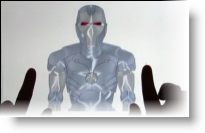Using a Multi-Touch Screen
SpaceClaim supports Microsoft® Touch technology for Windows. It allows you interact with your designs using a stylus or multiple fingers on a touch screen. Touch screens with multi-touch capabilities improve your work experience by providing:
User interface controls that are always close to a finger, so you use your mouse less often.
3D interaction, such as panning and rotating views, that offers a different navigation mechanism than with modifier keys or separate tools.
More intuitive selection, because you put your fingers directly on the geometry you want to manipulate.
Modeling in a more hands-on environment, so it feels more like working on a real part than a virtual part.
Real-time, interactive design reviews using large format multi-touch displays.

When using SpaceClaim's multi-touch feature, you can widen the SpaceClaim application window to span across two multi-touch monitors at the same time, or, you can move SpaceClaim between monitors to display the entire SpaceClaim window on either monitor.
While a significant effort was made to optimize the multi-touch functionality to fit (and enhance) the SpaceClaim user model, the intention was never to replace the mouse entirely. Touch should be used when it feels easier to do so, and the mouse should be used alongside the touch screen. The same philosophy applies to keyboard shortcuts and even to precise selection techniques. You are encouraged to try out touch to see where it improves the user experience and feedback is very welcome.
Touch is incorporated into SpaceClaim in many ways:
Navigation (Spin/Pan/Zoom/Rotate) uses emerging Microsoft standard gestures (those having been extended from 2D to 3D).
Precise selection of toolbar buttons is made easier by heads-up bubble notes, that appear over the icon that a finger may obscure.
Radial menus have been introduced to ease the choice of selection types, as a shortcut to get to major tools, and as a method to select edge loops.
A flick gesture takes the place of the missing mouse wheel to select objects that lie behind other objects.
Where possible, difficult selections have been made easier by automatic selection, such as the one axis that is free to move in the Move tool (on assembled components).
For HID-supported devices, SpaceClaim will use the faster HID signal.
For non-supported hardware, SpaceClaim will use the Windows built-in Multi-touch API.


